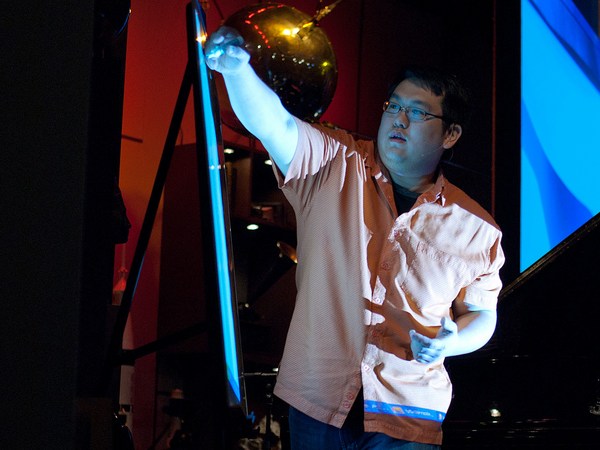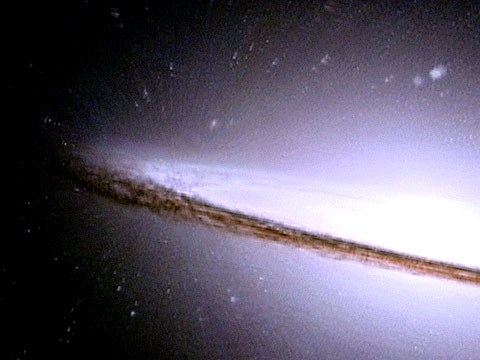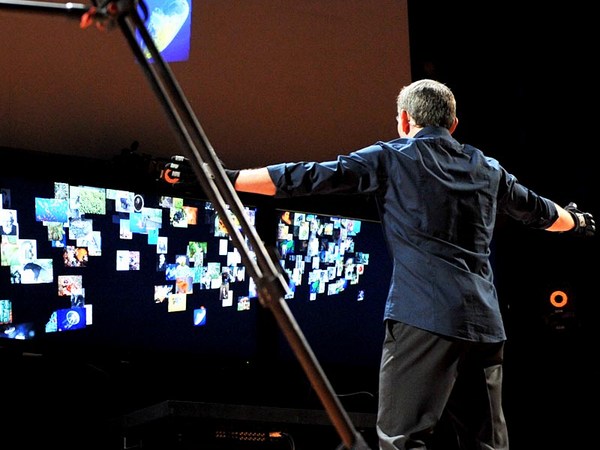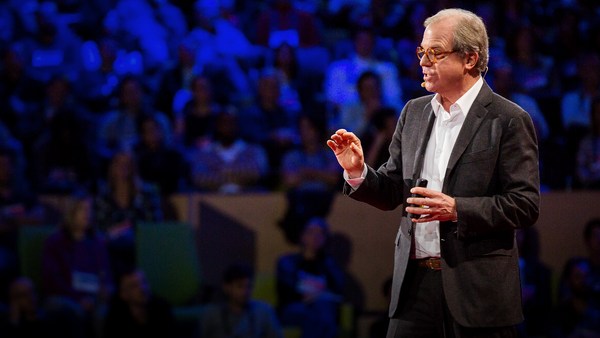So, I kind of believe that we're in like the "cave-painting" era of computer interfaces. Like, they're very kind of -- they don't go as deep or as emotionally engaging as they possibly could be and I'd like to change all that. Hit me. OK. So I mean, this is the kind of status quo interface, right? It's very flat, kind of rigid. And OK, so you could sex it up and like go to a much more lickable Mac, you know, but really it's the kind of same old crap we've had for the last, you know, 30 years. (Laughter) (Applause) Like I think we really put up with a lot of crap with our computers. I mean it's point and click, it's like the menus, icons, it's all the kind of same thing.
And so one kind of information space that I take inspiration from is my real desk. It's so much more subtle, so much more visceral -- you know, what's visible, what's not. And I'd like to bring that experience to the desktop. So I kind of have a -- this is BumpTop. It's kind of like a new approach to desktop computing. So you can bump things -- they're all physically, you know, manipulable and stuff. And instead of that point and click, it's like a push and pull, things collide as you'd expect them. Just like on my real desk, I can -- let me just grab these guys -- I can turn things into piles instead of just the folders that we have. And once things are in a pile I can browse them by throwing them into a grid, or you know, flip through them like a book or I can lay them out like a deck of cards. When they're laid out, I can pull things to new locations or delete things or just quickly sort a whole pile, you know, just immediately, right? And then, it's all smoothly animated, instead of these jarring changes you see in today's interfaces.
Also, if I want to add something to a pile, well, how do I do that? I just toss it to the pile, and it's added right to the top. It's a kind of nice way. Also some of the stuff we can do is, for these individual icons we thought -- I mean, how can we play with the idea of an icon, and push that further? And one of the things I can do is make it bigger if I want to emphasize it and make it more important.
But what's really cool is that since there's a physics simulation running under this, it's actually heavier. So the lighter stuff doesn't really move but if I throw it at the lighter guys, right? (Laughter) So it's cute, but it's also like a subtle channel of conveying information, right? This is heavy so it feels more important. So it's kind of cool.
Despite computers everywhere paper really hasn't disappeared, because it has a lot of, I think, valuable properties. And some of those we wanted to transfer to the icons in our system. So one of the things you can do to our icons, just like paper, is crease them and fold them, just like paper. Remember, you know, something for later. Or if you want to be destructive, you can just crumple it up and, you know, toss it to the corner. Also just like paper, around our workspace we'll pin things up to the wall to remember them later, and I can do the same thing here, and you know, you'll see post-it notes and things like that around people's offices. And I can pull them off when I want to work with them.
So, one of the criticisms of this kind of approach to organization is that, you know, "Okay, well my real desk is really messy. I don't want that mess on my computer." So one thing we have for that is like a grid align, kind of -- so you get that more traditional desktop. Things are kind of grid aligned. More boring, but you still have that kind of colliding and bumping. And you can still do fun things like make shelves on your desktop.
Let's just break this shelf. Okay, that shelf broke. I think beyond the icons, I think another really cool domain for this software -- I think it applies to more than just icons and your desktop -- but browsing photographs. I think you can really enrich the way we browse our photographs and bring it to that kind of shoebox of, you know, photos with your family on the kitchen table kind of thing. I can toss these things around. They're so much more tangible and touchable -- and you know I can double-click on something to take a look at it. And I can do all that kind of same stuff I showed you before. So I can pile things up, I can flip through it, I can, you know -- okay, let's move this photo to the back, let's delete this guy here, and I think it's just a much more rich kind of way of interacting with your information.
And that's BumpTop. Thanks!





